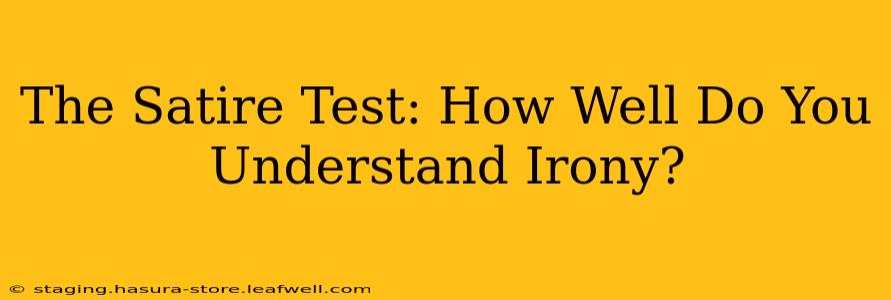Irony. Sarcasm. Satire. These words often get tossed around interchangeably, but they represent distinct literary devices, each with its own power to provoke thought and laughter. Understanding satire, in particular, requires a keen eye for the subtle (and sometimes not-so-subtle) ways authors use humor, exaggeration, and ridicule to expose and criticize folly, vice, or societal norms. This article will delve into the complexities of satire, helping you sharpen your understanding and become a more discerning reader and viewer.
What is Satire?
At its core, satire is a genre of literature, and more broadly, art, that uses humor, irony, exaggeration, or ridicule to expose and criticize foolishness and corruption of an individual or a society. It's not just about making people laugh; it's about making them think. Satirists aim to inspire change by highlighting the absurdity or hypocrisy of their targets. They often employ a variety of techniques, making the identification of satire a nuanced skill.
What are the Different Types of Satire?
Several distinct forms of satire exist, each employing different approaches to achieve its critical goals:
-
Horatian Satire: This gentle, playful form of satire uses wit and humor to subtly critique its subject. Think witty observations and lighthearted mockery rather than harsh condemnation.
-
Juvenalian Satire: In contrast to Horatian satire, Juvenalian satire is biting, angry, and often indignant. It uses harsh, bitter criticism to attack its target, leaving little room for ambiguity.
-
Direct Satire: This type of satire directly addresses its target, explicitly naming and criticizing the folly or vice being exposed.
-
Indirect Satire: This more subtle approach uses characters or situations to represent the flaws being criticized, allowing the reader to draw their own conclusions.
How Can I Tell if Something is Satire?
Identifying satire requires careful consideration of the text or artwork. Look for these key elements:
-
Irony: A central component of satire. Situational irony (where the outcome is the opposite of what's expected), dramatic irony (where the audience knows something the characters don't), and verbal irony (saying the opposite of what you mean) are all frequently employed.
-
Hyperbole: Exaggeration is a powerful tool in satire, used to emphasize the absurdity of the situation or character.
-
Caricature: Exaggerated representations of physical features or personality traits to create a comedic or critical effect.
-
Parody: Imitating the style of a particular work or genre to mock or criticize it.
-
Incongruity: Juxtaposing elements that don't logically belong together to highlight absurdity.
What are Some Famous Examples of Satire?
Many literary masterpieces utilize satire effectively:
-
Jonathan Swift's Gulliver's Travels: A classic example of satire, exploring societal issues through fantastical journeys.
-
George Orwell's Animal Farm: Uses allegorical animals to satirize totalitarian regimes.
-
Mark Twain's The Adventures of Huckleberry Finn: A complex work using satire to critique slavery and societal hypocrisy.
How Can I Improve My Understanding of Satire?
-
Analyze the context: Understanding the historical and social context surrounding the satirical work enhances appreciation of its aims.
-
Pay attention to the language: Satirists often employ wordplay, double meanings, and subtle allusions.
-
Look for recurring themes: Identify consistent criticisms or targets within the work.
-
Consider the author's intent: Try to understand the author's purpose in creating the satire—what message are they trying to convey?
Is all Humor Satire?
No. Humor encompasses a wide range of techniques, many of which are not satirical in nature. While satire can be humorous, humor doesn't automatically equate to satire. Humor aims to amuse, while satire aims to amuse and critique.
What is the difference between satire and sarcasm?
While often used together, satire and sarcasm are distinct. Sarcasm is a form of verbal irony, expressing the opposite of what one means. Satire, on the other hand, is a broader genre that may employ sarcasm, but also uses other techniques like exaggeration, parody, and caricature to achieve its critical aims.
Understanding satire requires more than just identifying humor; it involves deciphering the underlying message, recognizing the techniques employed, and appreciating the author's intent. By honing your skills in critical analysis, you can unlock the power and insight offered by this potent literary form.

